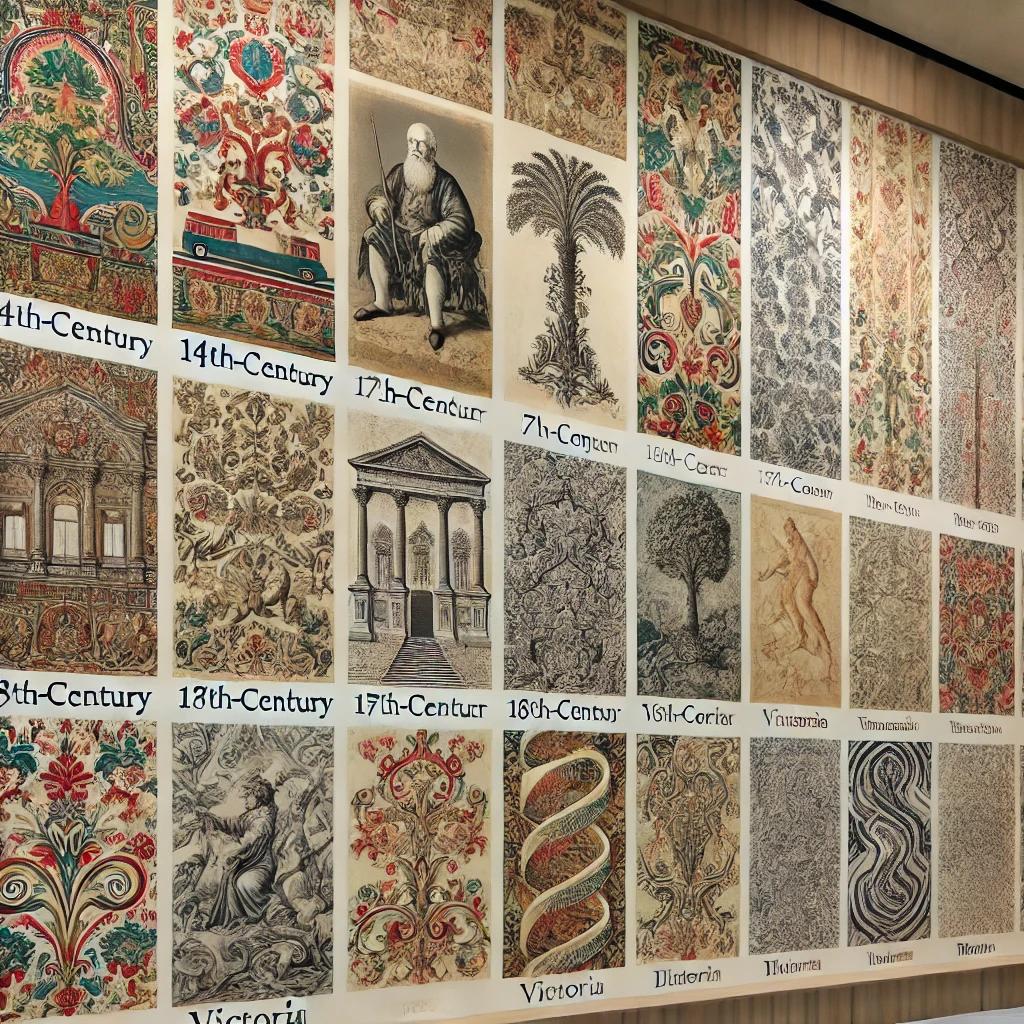Your cart is currently empty!
Historical Wallpaper Design

The Evolution of Wallpaper Design: A Journey Through History
Historical Wallpaper Design has been an integral part of interior design for centuries, transforming walls into canvases of artistic expression and storytelling. Its evolution mirrors cultural shifts, technological advancements, and artistic movements across the globe. Let’s explore the fascinating journey of wallpaper design through the ages.
1. Early Beginnings: 14th to 16th Century
The roots of wallpaper trace back to the Middle Ages when hand-painted or stenciled designs were applied to walls, mimicking the look of luxurious tapestries. These early wallpapers were crafted on small sheets of paper, often used as affordable alternatives to textile hangings, which were popular among the wealthy.
- Chinese Influence: During this period, Chinese hand-painted papers featuring intricate floral and bird motifs became highly sought after in Europe. These designs showcased remarkable detail and craftsmanship, setting a high standard for wallpaper art.
2. The Rise of Block Printing: 17th Century
The 17th century marked a turning point with the introduction of block printing. This method allowed for repetitive patterns and made wallpaper production more efficient. Designs during this era often featured:
- Baroque Patterns: Bold, symmetrical designs with floral and ornamental motifs reflecting the grandeur of the Baroque period.
- Pastoral Scenes: Inspired by paintings, wallpapers began depicting idyllic countryside landscapes and romanticized narratives.
3. The Golden Age of Wallpaper: 18th Century
The 18th century saw a surge in wallpaper’s popularity, fueled by technological innovations and changing tastes. Wallpaper became a status symbol, adorning the walls of aristocratic homes across Europe.
- Panoramic Wallpapers: Companies like Zuber & Cie in France pioneered scenic wallpapers, depicting elaborate landscapes, historical events, and exotic locations. These large-scale designs were akin to murals.
- Chinoiserie: Chinese-inspired designs continued to thrive, blending Eastern motifs with Western aesthetics.
- Industrial Advancements: The invention of machine-printed wallpaper made designs more accessible to the middle class, democratizing interior decoration.
4. Victorian Opulence: 19th Century
The Victorian era embraced wallpaper as a central element of interior design. Mass production and new printing techniques, like surface and rotary printing, revolutionized the industry.
- Rich Colors and Textures: Deep reds, greens, and golds dominated, with embossed and textured patterns mimicking fabrics like damask and brocade.
- William Morris and the Arts & Crafts Movement: Morris’s intricate, nature-inspired designs emphasized craftsmanship and rejected industrialization, leaving a lasting legacy on wallpaper design.
5. Modernism and Minimalism: Early 20th Century
The 20th century brought dramatic shifts in wallpaper trends, driven by changing lifestyles and artistic movements.
- Art Deco: The 1920s and ’30s saw sleek, geometric designs with metallic accents, reflecting the glamour of the era.
- Mid-Century Modern: Bold, abstract patterns and bright colors defined the post-war period, aligning with the clean lines of modernist architecture.
- Vinyl Wallpapers: Durable and washable, these became popular in the 1960s and ’70s, offering practicality alongside style.
6. Contemporary Revival: Late 20th Century to Present
Wallpaper experienced a revival in the late 20th century, evolving into a versatile design element for modern interiors.
- Digital Printing: Advances in digital technology have enabled intricate, custom designs, blurring the lines between art and wallpaper.
- Sustainability: Eco-friendly wallpapers made from recycled materials and non-toxic inks have gained traction.
- Peel-and-Stick: Temporary wallpapers cater to renters and those seeking flexibility in their decor.
7. The Future of Wallpaper
Today, wallpaper continues to push boundaries with innovations like 3D textures, LED-embedded designs, and interactive patterns. The fusion of technology and artistry ensures wallpaper remains a dynamic and enduring feature of interior design.
From its humble beginnings as a substitute for tapestries to its current role as a versatile design medium, wallpaper has continually evolved to reflect the tastes and technologies of its time. Its rich history offers endless inspiration for those seeking to transform their spaces.
Leave a Reply